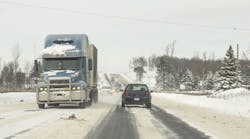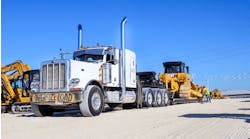Editor’s note: This is part one of a three-part series on readying fleets for harsh winter weather.
Running a fleet all comes down to control, with meticulous attention given to schedules, fuel costs, maintenance and drivers’ hours of service. No matter the number of vehicles under your purview—a dozen or a thousand—taking care of these constants should mitigate all those pesky variables, like accidents or breakdowns. You can’t control everything, after all.
And in the thralls of winter, when the unexpected white out or black ice could blow away best laid plans, you may feel in less control than ever, at the mercy of Alberta Clippers, polar vortices and local meteorologists' grasp of Doppler Radar.
If you run a modern commercial vehicle fleet, you are the master and commander of a highly sophisticated logistical network comprised of well-trained professional drivers and supremely engineered equipment. Your duty is no less than maintaining the continuous flow of goods throughout North America. There is plenty you can do to prepare your trucks—inside and out—for the coming snowpocalypse.
And you’ll need to, as the only thing that has been predicted is unpredictability.
The Farmer’s Almanac says the U.S. and Canada will experience a “polar coaster” this winter, which unfortunately promises more chills than thrills.
“We expect yet another wild ride this winter, with extreme temperature swings and hefty snowfalls,” noted Pete Geiger, editor of the almanac that is only four years younger than the U.S. Constitution.
Severe weather “and large swings in temperature and precipitation” could happen at a moment’s notice, in the absence of overarching climate patterns such as El Nino, said Mike Halpert, deputy director of the National Oceanic and Atmospheric Administration’s Climate Prediction Center.
Staying clean
Simple things like increasing wash intervals in snowy areas can do wonders for preserving trucks. A pressure wash every one to two weeks, rinsing wheel wells and under the chassis, will remove salt, an accelerant for oxidation and rusting.
Industrial vehicle cleaning solutions such as Cortec’s VpCI-406 exterior vehicle wash will remove the chunky charcoal grime and chalky salt spread across the exterior, while also leaving an inhibitor behind to prevent corrosion.
“Those corrosion inhibitors will prevent flash rust and they’ll just kind of stay behind on the surface and help protect it for short periods of time,” said Markus Bieber, vice president of integrated solutions for Cortec.
The state of Minnesota uses them on buses and snow plows, Bieber said, and keeping a vehicle clean and adding corrosive resistance can prevent rust damage that may accrue in as little as four years.
“Anytime you can remove those, that’s critical to extend the life of the unit,” Bieber said.
Snow removal
In a pinch we all used an old magazine, jacket sleeves or cardboard to clear wet snow off windshields. Extendable snow brushes tipped with bristles, scrapers and rubber squeegees are readily available on a plethora of websites, and range from $15 to $30.
That will take care of most areas of a truck, but the top of the trailer will need a more robust solution, and one that certainly does not involve climbing up there and shoveling it off, which evidently does still happen.
That’s a tragic reminder for Debora Katz, vice president at TrucBrush, who recalled hearing about someone falling and dying at the Mid-America Trucking Show in March of 2018. When an unexpected snowstorm hit the Louisville area, a driver clearing off their trailer prior to a truck beauty contest reportedly fell and died. It’s still too common of a practice.
“The top of a tractor trailer is one of the slipperiest you can ever imagine standing on,” she said. “Do you really want someone that high up trying to remove snow?”
As recently as last year, New Hampshire police stopped trucks and made drivers climb and clear snow off their roofs so it would not be hazardous to other drivers.
This was seen as enforcing Jessica’s Law, named for a woman who was killed 20 years ago in the state when a 9-ft. ice sheet flew off a tractor-trailer and struck her car.
Fines in New Hampshire can reach $500 for a first offense. In Connecticut, commercial operators are fined $500 to $1,250 if someone is injured or property damaged due to snow or ice coming onto their vehicle.
The TrucBrush solution attaches to a front loader, which is often used in terminals and depots to clear snow and attend to other material handling needs, in about a minute, and once the arms are raised, trucks drive under as hydraulic power spins the polypropylene bristles to remove snow and ice. It takes about 30 seconds for the entire tractor-trailer to pass under.
Katz said certain flatbed haulers also find the tool useful to clean off loads such as cement block that also accumulate snow.
“It substantially reduces snow clean-up time, which improves overall snow management at the facility,” said Pat Kane, president of Evercor Facility Management in Pennsylvania. “TrucBrush removes the need for anyone to be on or near the top of a trailer/truck.”





